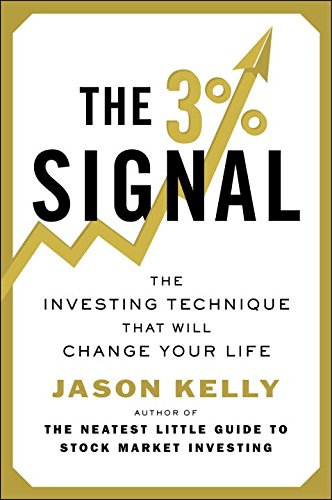That was the appeal behind the latest book I’ve been reading called “The 3% Signal” by Jason Kelly.
In case you’re not familiar with this author, Jason Kelly is a very well-known financial writer who created the “Neatest Little Guide to …” series on investing. “The Neatest Little Guide to Stock Market Investing” was one of the first personal finance books I ever read, and to this day I still hold it in high regard whenever anyone asks for a good-book recommendation.
In this latest release, The 3% Signal offers investors a very simple, yet effective (… as the author claims …) strategy for “locking-in” to returns and forcing yourself to follow the age-old investment principle of buy-low and sell-high.
Here’s a little bit more behind how the 3% Signal works:
How the 3% Signal Works
The strategy at work behind the 3% Signal is brilliantly simple.
It involves:
- Owning only two ETF’s
- Checking the price and buying/selling once every three months
Not too bad, right?
Here is the method:
- Start by putting 80% of your money into a small-cap index fund ETF and 20% into a bond index fund ETF. For example, if you’ve got $10,000, put $8,000 into the small-cap ETF and $2,000 into the bond ETF.
- At the end of the first quarter, calculate the 3% Signal for your stocks. This is simply a 3% increase in your stocks. So for your initial $8,000 investment, that would be 8,000 x 1.03 = $8,240.
- If your stock ETF’s are worth more than $8,240, then sell some of them and put the money with your bond ETF’s to bring your stock ETF value down to the 3% signal.
- If your stock ETF’s are worth less than $8,240, then sell some of your bond ETF’s to buy up more shares of stock ETF’s so that it brings you back up to the 3% Signal.
- Repeat every quarter!
Do you see what we’re doing there?
This method is forcing you to “lock-in” every quarter to a fixed 3% gain. You are making an emotionless, calculated effort to buy low and sell high, just like you’re supposed to!
Does It Work?
Would Kelly have written a whole book about it if he thought it didn’t work?
(… my opinions are at the end of this post …)
After Kelly presents his arguments for using this strategy, he offers several sets of data from December 2000 to June 2013 (50 quarters) that suggest that the 3% Signal would prove to be triumphant over an all stock.
Here’s a quick summary:
- The 3% Signal worked when you used the S&P 500 index instead of a small-cap stock index over just investing in the S&P 500 only.
- The 3% Signal worked when you used the small-cap index ETF IJR and bond ETF Vanguard GNMA over just investing in IJR only (both in instances that included with and without adding in new cash – more on this below).
Not only do you end up with a larger sum of money over time as opposed to the traditional dollar cost averaging method, it it also helps to stabilize your investments.
More so, Kelly spends quite a bit of time arguing that in reality buy-and-hold doesn’t work. It works on paper, but never in real life. This is because in real life, people are emotional and make rash decisions when the market makes wild fluctuations.
He characterizes this type of investor calling him “Peter Perfect” and makes the case that he doesn’t exist. Sure, people will pretend to be Peter Perfect and tell you about how much money you could have made if you had invested at this time or that. But does anyone ever really hit the nail on the head and invest at the perfect time every time? Of course not! In reality, they buy high and sell low as the market swings up and down. Most investors are far from being Peter Perfect even though they’d like you to think otherwise.
The 3% Signal is offered as a way around this. By taking away emotion and turning the process into something mechanical, you’ll avoid irrational mistakes and buy low, sell high as you’re supposed to do.
What Happens When You Run Out of Bond ETF Money?
If you read the strategy above and quickly observed a situation where you could run out of Bond ETF money to fund your stock ETF’s, you’re absolutely right. That will happen.
Kelly offers the solution to simply pump more cash into your portfolio. In our example above, this means that from time to time you’ll have to infuse more money than just your initial $10,000 investment.
Kelly offers figures both with and without the extra cash infusion, and suggests (of course) that the 3% Signal strategy comes out ahead.
This will be an important point later …
Sound TOO Good?
I’ll admit, like any good argument, it’s hard not to read Kelly’s arguments and feel captive to his suggestions. We as amateur investors really do sabotage our own efforts constantly by buying and selling at the wrong times.
So are you ready to take $10,000 and put the 3% Signal to work?
… Not so fast!
As smart investors, it’s important to never just jump in to any strategy without first asking the right questions. For example, it seemed a little too convenient that all of Kelly’s conclusions were based on data from the same time period of 2000-2013. What about other years or other time periods?
Also, generally speaking, Kelly is not the first person to suggest a re-balancing strategy such as this one. If it’s so effective, why don’t more financial professionals recommend it?
To get to the bottom of all of this, I downloaded my own data from Yahoo Finance and have been doing my own investigation. That’s exactly what I’ve been up to ever since I finished this book.
What have I found?
In the next post, I’ll share some of the results I came up with. Some of them may prove to be a little skeptical.
Overall, whether you think this strategy will work or not, if you like books about investing and methods that are a little more creative than the typical conventional advice, then I’m sure you’ll enjoy The 3% Signal. Though a little long-winded in some sections, Kelly does do a very good job of characterizing “real-world” investment habits and offers a method that may help us to prevent sabotaging our own portfolios.
Readers – Have any of you read Jason Kelly’s The 3% Signal book? If so, what did you think of it? Do you think this strategy will work as the author suggests?
Featured image courtesy of Amazon



I haven’t read the book, it seems like a typical rebalance strategy book. I’m interested to know the results you found for the other years. I feel if you buy and hold, and rebalance once a year, you will be fine. Even if you don’t rebalance, you should still have some growth on occasion within your funds, if you don’t, see growth over many years, then you picked the wrong funds.
Nice book review MMD. I am planning to grab a book by Jason Kelly. I have read good reviews about it and I am so excited to read it.
I have browsed the book by Jason Kelly of my friend. She said that it is a concise summary of the most important studies of behavioral finance and what they mean for investors. This book will teach you a conservative approach to investing that will bring you hopefully consistent results.
MMD, thanks for recommending another book. That book by Jason Kelly seems really good and will help me with the basics about investing or retirement. Gonna grab a copy of it this week.
Another book to read, MMD. I have read good reviews about 3% signal. by Jason Kelly and definitely gonna get a copy of this book one of these days. Thanks for bringing this up.